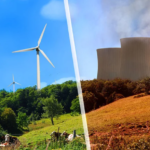In this edition of Cana – Jornal da Bioenergia, we spoke with the Minister of Agriculture, Livestock and Supply (Seapa), Pedro Leonardo Rezende, about the importance of sugarcane and corn for ethanol production in Goiás With a promising crop estimated at 76.6 million tons of sugarcane and a significant production of corn ethanol, Goiás stands out on the national scene.
Rezende discusses the challenges facing producers, the technological innovations adopted, and government initiatives that promote sustainability and efficiency in agricultural production. Follow the interview and discover how these cultures impact the state’s economy and social development.
Cana – Journal da Bioenergia: According to Conab, the corn crop in Goiás is expected to decline. As for sugarcane, forecasts indicate an estimated production of 76.6 million tons of sugarcane in Goiás in the 2023/24 season. How important are sugarcane and corn as raw materials for ethanol production in Goiás?
 Pedro Leonardo Rezende: Sugarcane and corn are essential for ethanol production in Goiás, helping to diversify our energy matrix and boost the state’s economy. Historically, sugarcane has been the main raw material for ethanol production, with high productivity and a well-established production cycle. In Goiás, we are the second largest producer of sugarcane ethanol in the country, with 4.72 billion liters in the 2024/25 harvest season, representing 17.3% of national production.
Pedro Leonardo Rezende: Sugarcane and corn are essential for ethanol production in Goiás, helping to diversify our energy matrix and boost the state’s economy. Historically, sugarcane has been the main raw material for ethanol production, with high productivity and a well-established production cycle. In Goiás, we are the second largest producer of sugarcane ethanol in the country, with 4.72 billion liters in the 2024/25 harvest season, representing 17.3% of national production.
On the other hand, corn appears as a promising alternative. With high yields per ton of raw material and production potential during the sugarcane season, corn ethanol has grown significantly. Goiás is the third largest producer of corn ethanol, with a production of 686 million liters in the 2024/25 season, representing 10% of national production. Moreover, corn ethanol production generates valuable co-products such as DDG – or dried distillers grains – used in animal feed.
Channel: How has the production of these crops developed in recent years in the state?
Pedro Leonardo: Sugarcane production remained stable, with a slight decline of -1.2% in production in the 2024/25 season, totaling 75.7 million tonnes, reaffirming the continued importance of sugarcane to our sugar energy sector. As for corn, production has grown in recent years due to demand for ethanol and an expansion in the planted area. However, Conab expects the 2023/24 crop to decline to 10.7 million tonnes, due to a decrease in the planted area (-13.7%) and a slight decrease in yield (-1.7%).
Channel: What are the main challenges facing the production of ethanol from these raw materials?
Pedro Leonardo: For sugarcane, the main challenges are the dependence on favourable weather conditions, the need to regenerate sugarcane fields, pest and disease management, and the search for more productive and resistant varieties. The 2.3% decline in sugarcane yields in the 2024/25 season, as reported by Conab, reflects these challenges.
In the case of maize, we face price volatility on the international market, competition with other crops, and the need to ensure food security, as maize is vital for human and animal nutrition. The decline in planted area and maize production in the 2023/24 harvest season highlights these challenges.
Channel: What technologies and innovations are being implemented to improve efficiency and sustainability in sugarcane and corn production?
Pedro Leonardo: The Ministry of Agriculture of the State of Goiás is committed to modernizing and making sustainable agricultural production of sugarcane and corn, and is actively promoting the adoption of innovative technologies. Among the tools, precision agriculture stands out, which optimizes the use of resources such as water and fertilizers through sensors, drones and software, as well as the development of more productive varieties that are resistant to pests and diseases, and adapted to climatic conditions. Goiás.
Other initiatives include integrated pest management with biological control, implementation of efficient irrigation systems such as drip and micro-sprinkler, and use of biotechnology to develop more resistant plants and improve efficiency in ethanol production. These actions aim to promote a more modern, sustainable and competitive agriculture in the state.
Channel: Are there any government incentives or programs that support producers in adopting these technologies?
Pedro Leonardo: The Government of Goiás offers several incentives to support producers in adopting these technologies. These include credit lines at reduced interest rates, technical assistance and training. A recent example is Bill No. 374/2024, which aims to create tax benefits for industrial facilities that produce hydro-ethanol fuel in the country, regardless of the raw material used. Furthermore, we are constantly investing in research and development to create technologies and solutions for the energy and sugar sectors.
Channel: What initiatives are being adopted to promote sustainability in sugarcane and corn production?
Pedro Leonardo: The Ministry of Agriculture has promoted sustainability in sugarcane and corn production through several initiatives, with a focus on the State Bio-Input Policy and the Integration of Crops, Livestock and Forests (ILPF). The State Bio-Input Policy, established by Law No. 21.005/2021, aims to expand the adoption of sustainable practices in the agricultural sector, encouraging the use of bio-inputs and production systems that respect the economic, environmental and social dimensions. The ILPF seeks to intensify sustainable practices in this area, restore degraded areas and integrate diverse production systems on the same property, with benefits for all activities.
In addition, the Secretariat also promotes other sustainable practices, such as direct planting, crop rotation, integrated pest and disease management, efficient water use, and renewable energy generation from sugarcane and maize biomass. These joint actions aim to ensure responsible food production, preserve the environment, and promote the country’s economic and social development.
Channel: What is the economic impact of sugarcane and corn production on the economy of Goiás? What are the social benefits of growing these crops in the state?
Pedro Leonardo: Sugarcane and corn production has a significant economic impact in Goiás, generating jobs and income. The sugar and energy sector is one of the main drivers of the state’s economy, contributing to the development of many regions. We rank third in total national ethanol production with 5.4 billion liters in the 2024/25 season, representing 15.8% of national production.
Social benefits include direct and indirect job creation, increased income for rural populations, infrastructure development and improved quality of life in producing communities. Ethanol produced in Goiás supplies the local market and is also exported to countries such as India, the United States and Australia.
Channel: What are the main messages that the Ministry of Agriculture of Goiás wants to convey to producers and residents about the future of sugarcane and corn production in the state?
Pedro Leonardo: We reaffirm our commitment to the sustainable development of the energy and sugar sector, and to promote the adoption of technologies and practices that increase efficiency, productivity and sustainability in sugarcane and corn production. Our goal is to strengthen the state of Goiás as an important center for the production and export of ethanol, generating economic and social benefits for all residents.
We also highlight the importance of investing in research and development to address sector challenges, such as the search for more pest and disease resistant varieties, efficient water use and reduced reliance on chemical fertilizers. We will continue to promote diversification of the energy matrix, and encourage the use of biofuels and other renewable energy sources. (Channel – Bioenergy Magazine)



